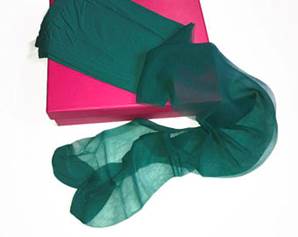
Pantyhose

"Pantyhose are generally made from a nylon-based blend of synthetic fibers. The nylon most commonly used—Nylon 6,6—is made from adipic acid, an organic acid, and hexamethylene diamine, an organic base, which are chemically combined to form a nylon salt. Because nylon is a plastic material—actually the first thermoplastic fiber ever used—the salt must undergo polymerization. In this process, different molecules are combined to form longer molecular chains. These chains result in a smooth, thick substance that is then cut into small shapes or pellets, before being spun into yarn. The nylon fiber's size, strength, weight, elasticity, and luster are determined during its preparation by controlling the number and type of filaments used. For example, luster is produced by adding titanium dioxide (TiO 2 ). The resulting fiber is highly elastic and retains its shape after repeated washings and stretchings. Its resistance to wrinkles and creases, its durability, and the fact that it dries quickly make it a desirable fabric for busy women.
Today, filaments of another synthetic fiber, spandex, are frequently combined with nylon filaments to increase elasticity and achieve a snugger fit. More recently, other new fibers known as microfibers or microdeniers have been blended with nylon.
... Nylon is made in a process known as 'melt spinning'. First, a syrupy polymer solution is produced and then extruded through a spinneret. As the nylon strings emerge, they are cooled by air and stretched over rollers to stabilize the molecular chains and strengthen the fibers. The yarn is then wound on spools. Next, the yarn is fed into a computer-controlled circular knitting machine, which uses its 300 to 420 needles to convert the nylon into a series of loops. It takes about 90 seconds to knit a full-length stocking leg."
Reduce purchases of nylon-based pantyhose by purchasing ethically and sustainably-sourced items.
Unworn and barely-worn, clean pantyhose can be donated to charity/secondhand shops.
There are many creative ideas online for reusing pantyhose. For example ...
- cut a leg off old pantyhose, fill with soap remnants and tie around your garden tap to provide an easy hand-washing solution when you are outside gardening
- use to store onions, garlic bulbs
- cut up to use as plant ties in the garden - they are gentle on plant stems
- use to sieve lumps out of paint
More ideas to reuse pantyhose in the garden and home. And even more here!
Nylon-based pantyhose will not biodegrade in landfill, please find other uses wherever possible.